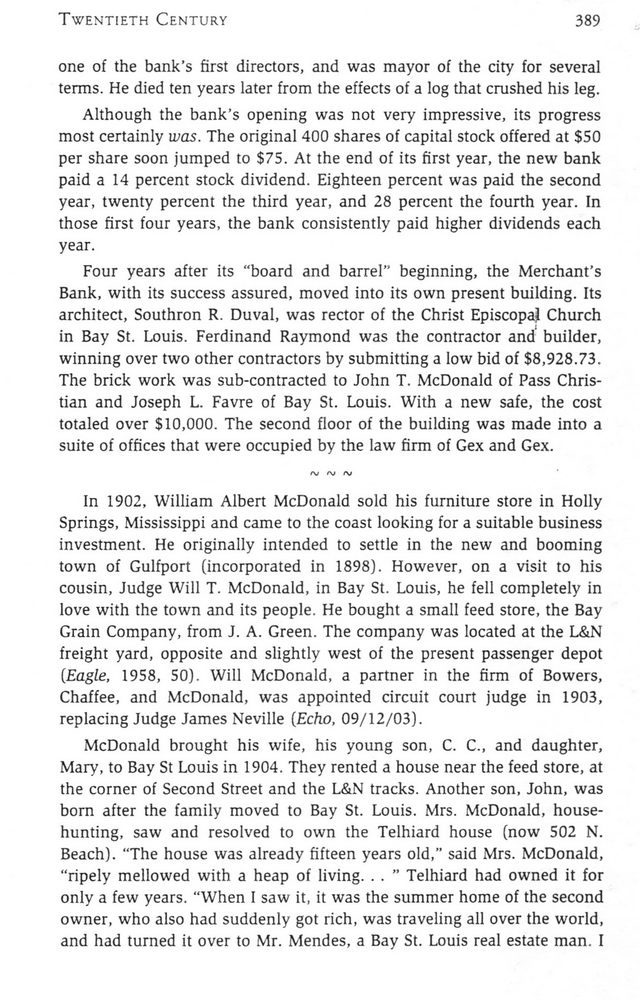This text was obtained via automated optical character recognition.
It has not been edited and may therefore contain several errors.
Twentieth Century
389
one of the bank?s first directors, and was mayor of the city for several terms. He died ten years later from the effects of a log that crushed his leg.
Although the bank?s opening was not very impressive, its progress most certainly was. The original 400 shares of capital stock offered at $50 per share soon jumped to $75. At the end of its first year, the new bank paid a 14 percent stock dividend. Eighteen percent was paid the second year, twenty percent the third year, and 28 percent the fourth year. In those first four years, the bank consistently paid higher dividends each year.
Four years after its ?board and barrel? beginning, the Merchant?s Bank, with its success assured, moved into its own present building. Its architect, Southron R. Duval, was rector of the Christ Episcopal Church in Bay St. Louis. Ferdinand Raymond was the contractor and builder, winning over two other contractors by submitting a low bid of $8,928.73. The brick work was sub-contracted to John T. McDonald of Pass Christian and Joseph L. Favre of Bay St. Louis. With a new safe, the cost totaled over $10,000. The second floor of the building was made into a suite of offices that were occupied by the law firm of Gex and Gex.
rv f\t rv
In 1902, William Albert McDonald sold his furniture store in Holly Springs, Mississippi and came to the coast looking for a suitable business investment. He originally intended to settle in the new and booming town of Gulfport (incorporated in 1898). However, on a visit to his cousin, Judge Will T. McDonald, in Bay St. Louis, he fell completely in love with the town and its people. He bought a small feed store, the Bay Grain Company, from J. A. Green. The company was located at the L&N freight yard, opposite and slightly west of the present passenger depot {Eagle, 1958, 50). Will McDonald, a partner in the firm of Bowers, Chaffee, and McDonald, was appointed circuit court judge in 1903, replacing Judge James Neville {Echo, 09/12/03).
McDonald brought his wife, his young son, C. C., and daughter, Mary, to Bay St Louis in 1904. They rented a house near the feed store, at the corner of Second Street and the L&N tracks. Another son, John, was born after the family moved to Bay St. Louis. Mrs. McDonald, househunting, saw and resolved to own the Telhiard house (now 502 N. Beach). ?The house was already fifteen years old,? said Mrs. McDonald, ?ripely mellowed with a heap of living. . . ? Telhiard had owned it for only a few years. ?When I saw it, it was the summer home of the second owner, who also had suddenly got rich, was traveling all over the world, and had turned it over to Mr. Mendes, a Bay St. Louis real estate man. I

Gardebled Louisiana's-Loss-Mississippi's-Gain-page-389